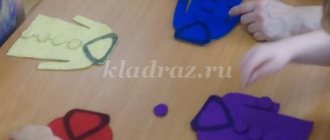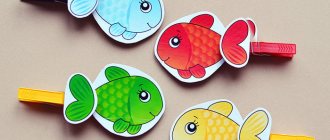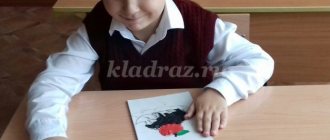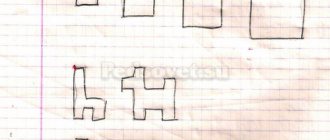WHY DO YOU NEED TO DEVELOP MOTOR SKILLS?
Finger control is the most important skill for a person. It is used in almost any activity related to study or work. Without the ability to carefully measure every movement, it is impossible to master writing, drawing, or typing on a computer. Even everyday tasks such as tying shoelaces or untangling headphone cords require a high level of finger control. That is why attention is paid to motor development from the earliest years of the baby.
Scientists have long identified a connection between finger skills and intellectual development. Training hand flexibility and dexterity also puts stress on those areas of the cerebral cortex that are responsible for memory, attention, speech and visual perception of information. Thus, improving the accuracy and strength of finger pressure directly affects the child’s other abilities.
Many games in kindergarten and at home are aimed at developing skills that will be useful in first grade, and training hand dexterity is no exception. It will become the basis for learning to write and the further formation of beautiful handwriting. Therefore, the development of fine motor skills in young children requires special attention. What important nuances do parents need to take into account?
How fine motor skills develop
The motor skills of a five-year-old and an infant are significantly different. Babies are just learning to control their hands, having only a grasping reflex in their arsenal. Later it transforms into a purposeful gesture that will allow the child to reach his favorite rattle, and then get to his feet.
During infancy, fine motor skills develop through tactile perception. The baby enjoys running his fingers over objects with different textures and learns to recognize information that is transmitted through sensations. At this time, a powerful foundation is laid for further development and a fulfilling life, because the ability to feel the texture of an object with our fingertips allows us to navigate in the dark, play musical instruments, etc.
- By the end of the first year of life, the baby firmly holds small objects, knocks toys on a hard surface, and knows how to lay out and assemble a pyramid.
- From 2 to 3 years old, palm movements actively develop, and grasping of an object with the index and thumb appears.
- At 3-4 years old, the baby’s hand movements are coordinated and aimed at solving a specific problem. He can spend a long time drawing, sculpting, buttoning and unbuttoning clothes.
- From the age of 5, a child can easily handle a zipper, tie shoelaces, can independently untie a knot, work with scissors, and draw straight lines and geometric shapes.
DEVELOPMENT OF FINE MOTOR SKILLS IN YOUNG CHILDREN
Whether it’s training fine motor skills or developing other skills, when it comes to a child, parents should take into account a number of recommendations to ensure that the activities are both productive and harmless. First of all, you need to select exercises that include elements of the game. The child should not be overworked and tired from training, otherwise he will lose motivation to train. In such a case, it will be very difficult to achieve any visible result.
When a child is asked to complete a particular task, parents should be present next to him and actively participate in the training process. Help your child if he has difficulties with any exercise, and praise him even if not everything works out. Then the training will not cause negative associations in the child.
Classes should not take much time. It is better to do several short workouts than to perform the same exercise for a long time. Choose a few games that help your child develop his motor skills and alternate them throughout the week. The more varied the load, the easier it will be to maintain the baby’s interest.
The effectiveness of such training largely depends on the choice of educational games and exercises. Let's talk about which of them are best suited for the development of fine motor skills in children at an early age.
Games and exercises aimed at developing fine motor skills
The main activity of preschool children is play. We have selected a variety of games and exercises for you, among which you will definitely find something that suits you and your child.
- Folding toys. We place a transparent container in front of the child and place small toys separately. We suggest putting toys into the container with your right hand. Then we pour them back and ask you to repeat the same actions with your left hand.
- Games with cereals. In one container we mix two types of cereals, for example, rice and buckwheat. It is necessary for the child to put these cereals into different containers. You can complicate the game by adding other small objects to the mixture of cereals, for example, beads, buttons, pebbles.
- Exercise for tearing a sheet of paper. First, draw random lines on a sheet of paper. We invite the child to tear the paper with his hands exactly along the drawn lines. You can complicate the task by depicting geometric shapes.
- Page turning exercise. As your child gets older, instead of tearing a sheet of paper, you can suggest flipping through the pages of a favorite book. This exercise also promotes the child's early interest in reading literature.
- Smoothing out a crumpled sheet of paper. We place a crumpled sheet of paper in front of the child and offer to smooth it out so that not a single bent corner remains. You can complicate the exercise by suggesting that you do it with one hand, while holding the sheet with your thumb.
- Games with cubes. We give the task to assemble various figures from cubes: a tower, a house, a car, etc. Pyramid rings are also suitable for these games. The tasks become more complicated as the child masters the construction of simple figures.
- Games with lacing. Available in various options. It can also be an unnecessary shoe that you can let your child lace and unlace. It could also be a card with holes for laces. In any case, the actions with these objects are the same and pursue the same goal - to teach the child to cope with shoelaces on his own, since this skill will be useful to him in the future.
- Exercises with counting sticks. Please place geometric shapes on the table. First, the child completes tasks according to the model, and then independently according to verbal instructions. An additional advantage of this exercise is the formation of elementary mathematical concepts.
- Games with lids. Here you can offer various containers and vessels with lids that the child will independently twist and unscrew. And if you tell your child that you can’t cope without him, you will give him a motive to become your main assistant.
- Finger drawing in the sand. Invite your child to draw geometric shapes or any other design he wishes with all his fingers one by one. Interaction with sand also has a positive effect on the central nervous system.
EDUCATIONAL GAMES FOR HAND MOTOR SKILLS
Modern kindergarten teachers and school teachers often note that the motor development of children leaves much to be desired. There are a number of games and exercises that can improve finger mobility and flexibility. Let's consider those that are suitable even for small children and bring the best results:
- finger games. The main advantage of such exercises is that they are suitable even for the smallest. Finger games are both fun nursery rhymes that lift the baby’s spirits, and important training for the mobility and flexibility of a child’s hands.
- origami. Folding various paper figures contributes not only to the development of finger flexibility, but also to the formation of perseverance in young children. At first, such exercises will be difficult, but gradually the kids will improve their skills and learn to give paper the most unexpected shapes.
- modeling from plasticine or dough. This type of creativity promotes the development of finger motor skills and perfectly trains the hands. In order for the intended figure to turn out, you need to carefully measure every movement, because pressing too softly or too hard can ruin the work.
- lacing. Even the simple act of tying shoelaces is important fine motor practice. You can also encourage your child to untangle loose knots on strings - this exercise will help kids learn to better control their finger movements.
- constructor assembly. Today you can find many options for these toys to suit every taste. In addition to the benefits for finger development, children learn to use their imagination and act unconventionally. They arrange the parts at their own discretion and assemble a variety of figures from the same set - a house, a car, robots, and so on.
- drawing. When a baby draws with a pencil or paints, he learns to express his imagination on paper. In addition, he has to strain his fingers and control their work, which has a positive effect on motor development. Drawing can be called a preparatory stage for learning to write.
Thus, the development of fine motor skills in children in preschool age is a kind of preparation for entering the first grade. But it is necessary to improve children’s skills in many ways, because flexibility and mobility of fingers is only one of the basic abilities that need to be trained. Let's talk about programs that develop both hand motor skills and intelligence of preschoolers.
Fine motor skills in children from 1 to 3 months
At the age of up to 1 month, in accordance with the norms of child development, the baby’s hands are usually clenched into fists, and the fingers clasp the thumb. If you put a rattle in his hand, he can grab it, and that's all for now. If you run your finger across your baby's palm, he will grab it tightly. However, you should not try to lift it - the child may suddenly let go of the finger. This is just one of many infant reflexes that a child has from birth - the palmar grasp reflex, and the baby has no control over it. At about 3 months of age, the baby's arms begin to relax. The palm is in a half-open position most of the time. Now, if you put a rattle in his hand, he can grab it, bring it to his mouth, or drop it when he stops being interested.
How to develop hand motor skills in a child from 1 to 3 months
During this period, the following actions are recommended for the development of the child:
- Shake a toy in front of him or over his head. The child will reach for it or pat it with his hand.
- Give your child bright objects, if possible in different sizes, shapes and textures.
Summarize
| At this stage, the child develops the following elements of hand motor skills: ● He can squeeze and unclench his palm. ● He brings his hands to his mouth. ● He can hold a toy like a rattle and shake it. |
WHAT METHODS IS BETTER TO CHOOSE
To successfully adapt to school, your child must come to first grade prepared. To do this, you need to take a large-scale approach to developing his abilities. In addition to fine motor skills, it is also necessary to train logical thinking, memory, and expand creativity. A technique that copes well with this task, and also teaches children to quickly count in their heads, is mental arithmetic.
It is based on calculations on special accounts - the abacus. First, kids learn to move the abacus bones, master the operating principle of this instrument, and later try to perform simple mathematical operations on them. When this method of calculation no longer causes difficulties, children learn to imagine the abacus in their minds and count on it. Over time, skills are honed, and kids show amazing results, because they manage to make calculations even faster than adults do on a calculator.
The key feature of mental arithmetic is the simultaneous use of two hemispheres of the brain: the left, which allows you to think logically and analytically, and the right, which is responsible for creativity and creativity. Such a diverse load makes the human brain work more productively, which has a positive effect on a variety of areas of intelligence:
- Memory and memorization are trained, as well as skills in working with information.
- logical thinking and analytical abilities develop.
- Creative potential expands and creative thinking develops.
- the reaction speed increases, allowing you to more quickly respond to tasks and solve them faster.
- Concentration improves, which greatly helps to maintain attention in school lessons.
- interhemispheric connections are formed, allowing you to study more effectively at school and at home.
In addition, mental arithmetic is an excellent fine motor skills trainer and a means of learning how to quickly count in your head without using a calculator. The advantages that this technique provides make it one of the most effective programs for the development of children of preschool and school age.
Learning mental arithmetic is a great way to prepare for school. The motor and intellectual development of the child, which can be achieved through this program, will become an important basis for later life. Mental arithmetic skills will be preserved forever, which means that even in adulthood, this technique will again and again help you achieve success in any endeavor.
Fine motor skills in children from 4 to 7 months
At 4 months, in accordance with the norms of child development, the baby usually holds the rattle tightly, can shake it, put it in his mouth and even transfer it from hand to hand. At the age of 4 to 7 months, the child uses his palms as claws or a rake, that is, he lifts objects of interest to him with a raking motion. The baby can also grab an object with one hand, transfer it to the other, and make a rotational movement of the wrist towards himself in order to examine the thing.
How to develop hand motor skills in a child from 4 to 7 months
What can be done for the development of a child at this age:
- Place toys at some distance from the baby so that he has an incentive to reach for them.
- Let him play with blocks and stuffed animals to develop his hand-eye coordination.
Summarize
| So, a baby between the ages of 4 and 7 months usually develops the following elements of hand motor skills: ● He can reach for objects with one hand. ● He transfers objects from one hand to another. ● He can lift objects using a raking motion with his palm. |
Fine motor skills in children from 8 to 12 months
From 8 months to 1 year, the child’s general motor skills rapidly develop: as a rule, he can already crawl, stand up independently, and sometimes even walk. But hand motor skills are not far behind, you just need to take a closer look. At this stage, in accordance with the norms of child development, the baby switches from a raking movement to clamping an object between the thumb and index or middle finger. This way he is able to lift even small objects the size of a corn ring or a breakfast ball. You can even show him how to snap his fingers, and sometimes the child is even able to repeat it! Don't be surprised if your baby starts throwing things at this age. He'll be so excited about his new, improved hand coordination that he'll enjoy picking up objects and throwing them, hoping you'll pick them up and give them to him. With these actions, the child learns to understand the relationship between cause and effect, and also tries to attract your attention. If he starts throwing toys, encourage him to play with soft balls rather than wooden blocks. At this stage, it is best to remove all fragile objects from your baby, otherwise he may throw a salt shaker or your phone on the floor. For his and your safety, we recommend temporarily switching to plastic utensils. By the way, as part of measures to ensure the safety of your child’s home, remove fragile decorative elements, such as vases, away.
How to develop hand motor skills in a child from 8 to 12 months
For the development of a child at this age, it is useful to play joint games aimed at coordinating hands and fingers. Here are some examples:
- Sit on the floor next to your baby and take a large ball (and if the ball rings or rattles, it will be even more interesting for the baby). Roll the ball towards the child. Let him roll it towards you too. At first, the baby will simply clap the ball, but over time he will learn to roll it purposefully.
- Give your baby something that opens and closes, such as a box with a lid. You can hide your baby’s favorite toy in the box and say “peek-a-boo” when he lifts the lid.
- Give your child a basket with different items: soft toys, balls, safe household items like wooden spoons and cups. Let the baby take them one at a time from the basket and put them back. At this time, you can tell your child the name of each object, what its shape, texture and color are.
- At this age, children love latches, wheels, levers, hinges - in general, anything that can move. Try to choose toys for him with these properties.
Summarize
| A child aged 8 to 12 months develops the following elements of hand and finger motor skills: ● He can grasp objects by holding them between the thumb and forefinger, shake them, hit them, transfer them from hand to hand, release them arbitrarily or throw them. ● He can knock objects together to make sounds (like wooden blocks). ● He can build towers from cubes and break them. ● He puts toys and other items in the container and takes them back out. ● He can stick his index finger into the holes. ● He holds the crayon or pencil in his fist and moves it across the surface. |







